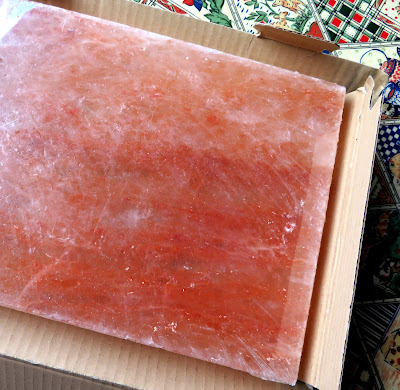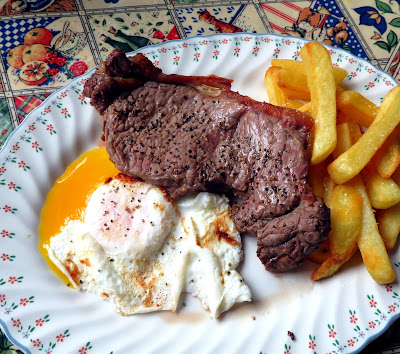What you are looking at is a plate of Steak and Eggs. There is nothing so unusual to that you might be thinking, but . . . what if I told you I had cooked it on a block of Himalayan Sea Salt? Is your interest yet piqued?
They come in a whole variety of sizes, from small individually sized ones, to larger ones. You can use them for all sorts and they really make for a unique presentation of raw or cold foods, imparting a tiny bit of flavour to the foods as they sit upon its surface.
Above is an example of one being used with chacuterie tray.
They also make for unique, simple and attractive hors d'ouvres trays. This one has basil leaves topped with some buffalo mozzarella, ripe tomatoes, a drizzle of balsamic and some basil pesto.
Most excitingly, the Himalayan salt block is rich in mineral salt, which
flavours – or even cures – the food served on the salt plate.
You can cook anything from eggs to steaks, to fish, vegetables, etc. on them. I can't think of anything that you couldn't cook on them, except for maybe soup, and the reason for that should be patently obvious.
I got my Salt Plate from a company called Sous Chef, which is a company that experts at providing unique and quality gifts for cooks, professional and otherwise. You can find a wide range of ingredients, equipment, tools, etc. on their site. If I was buying a gift for a foodie, that is where I would check first. They often stock items that you have a difficult time finding or can't find anywhere else. I love them.
The company was founded in 2012 by a woman named Nicola Lando who was frustrated with the lack of range and quality of ingredients to be found in the shops. Sous Chef now offers over 4,000 carefully selected products from around the world. If you are looking for a foodie type of a gift for Christmas, this is the place to start.
My pink plate Terre Exotique was carved deep n the heart of the Himalaya in the Pakistani region of Kasmir.
This thing is damn heavy, so be forewarned. If you drop this baby on your toes, chances are your toes are going to be broken! Take care!
Salt blocks can be heated or cooled to extremely hot and cold temperatures which makes them extremely versatile. Being a natural product with imperfections and lines, it is important to do this slowly. Heating a salt block too quickly can cause it to crack or otherwise break. If you treat it with care however it can last for a really long time.
Its extremely important to heat a salt block carefully, especially when using it for the first few times. This will help to ensure the strength of the salt block over the long term and will help to improve its performance as a cooking surface. This process is called tempering. Its really not all that difficult to do.
- Place block in the oven on a low rack
- Turn oven on to lowest setting (76*C/ 170*F)
- Leave it for 30 minutes at this temperature Increase temperature by 50 degrees and leave another 30 minutes
- Repeat this process, raising 50 degrees every 30 minutes, until it reaches a temperature over 260*C/500*F
- Turn the oven off and leave the salt block there, with the door closed, until it completely cools to room temperature
Don't worry if it makes some crazy crackling noises and develops a few visible lines when you are tempering it. This is quite normal.
When you go to cook on it for the first time you will want to begin by heating it slowly. It is important to do this with care in order to prolong the life of your salt plate. Its a bit more complicated than using an ordinary skillet, and does take a bit more time, but it is well worth the extra care given in the long run. Once you get use to doing it, it won't seem as complicated and you can build the time it takes into your cookery schedule and timings.
HOW TO HEAT YOUR BLOCK ON A STOVE TOP
- Make sure it is completely clean and dry and that it has been at least 24 hours since it was wet.
- Place the salt block over a gas burner (or over an electric range, but place a metal ring or grate of some kind in between to allow air to flow between).
- Turn the heat on low and set a timer for 15-20 minutes (depending on size- larger blocks take longer). Increase the heat to medium and leave for another 15-20 minutes.
- Turn up again to medium/high for another 10-15 minutes.
- If you have one, use a laser thermometer to make sure the block is around 500 degrees. Don’t have one? Splatter a few drops of water on the salt and make sure they dance and evaporate immediately. Be careful not to touch it. Once heated salt blocks really maintain the heat for a long time.
HOW TO HEAT YOUR SALT BLOCK ON AN OUTDOOR GRILL
- Salt blocks can be used on gas and charcoal grills.
- On gas grills, start with low heat just as you would on a gas stove and work up slowly.
- With a charcoal grill, put all the charcoal on one side and the salt block on the other.
- Watch the temperature carefully to ensure it doesn’t heat up too fast.
It is the thickness and strength of a salt blocks which make them such an amazing surface to cook on. Once heated, they will hold their temperature for quite a while without a heat source. When you use it on a grill, it also adds a delicious smoky and mild lightly salty flavor to what you are cooking on it.
Once your salt block is pre-heated you are ready to cook on it. The bonus of the length of time that it takes to preheat it means that you have extra time to get all of your ingredients prepped and ready to cook. Mis-en-place.
RULES OF ENGAGEMENT
(or things to remember when cooking with a salt block)
- The block must be fully heated before using. A block that hasn't been heated enough will actually over-salt and under cook food.
- Fast-cooking foods are best. They work well for things like steaks, chicken breasts, thighs, seafood, fish, etc. You wouldn’t want to make a roast or any foods that take a long time to cook on a salt block. Typically, the faster the food cooks, the better it works on a salt block. Vegetables like asparagus, halved tomatoes and sliced courgettes or eggplant also great.
- Don’t ever use oil on the block. The oil will work itself into cracks in the salt and eventually go rancid. It may even catch fire first while you are grilling/cooking.
- Keep on cooking. Once you preheat the block, you can cook on it for several hours. If you wanted to you could cook your whole meal and dessert on the salt block to maximise its use.
TAKING CARE OF YOUR SALT BLOCK
Remember always if you are using a salt block to cook with that patience is your key. Things need to happen slowly. There is no rushing it. This is an event. Treat it as such and it will be a much more enjoyable experience. Also do take care not to ever put it into the dishwasher. Water and salt don't mix very well. All you will end up with is a very salty dishwasher, and a salt block that has done a disappearing act.
- Let it cool naturally and completely after cooking. It must be completely cool before cleaning.
- Salt is naturally antibacterial and easy to clean. Do not use soap and use as little water as possible. The more water you use the faster the salt block will wear away since each washing will remove a tiny layer of salt.
- Use a scouring pad or sponge to scrub it down and remove any food residue.
- Do a final wipe with a clean, slightly wet sponge.
- Towel dry with a clean towel and allow to air-dry for 24 hours before you use it again.
I cooked some Steak and Eggs for Todd on ours today. I started off with the steak. This was the first time I had actually cooked on it. The steak didn't get that golden brown sear that I would have gotten in a skillet, but I have to say it tasted amazing.
I just cooked the egg on the residual heat from the salt block after I had cooked the steak. That also tasted amazing. I did clumsily break the yolk, but it didn't matter to Todd. He said it was one of the nicest meals he had enjoyed in a long time.
I'm not sure what that says about the rest of the meals I have been preparing for him in recent months, but we just won't go there, and take it as a win all the same!
If you are interested in getting a Salt Plate/Block for yourself, do check out Sous Chef. You won't be sorry that you did. You can check out all of their other goodies while you are at it.
I wanted to add a photo of the salt block/plate after cleaning. As you can see above where I am cooking the egg on it, it had quite a bit of residue on it, and of course this was quite baked on, especially egg. You know how hard egg is to get off things. It didn't take me very long to clean at all. I scrape it a bit with a metal spatula to get the worst off and then I used a slightly damp scrubbie pad to scrub the rest off, finally wiping it with a damp cloth and then a dry cloth. It looks almost as good as new and took me less than 10 minutes!! Todd was surprised when I called him in to look at it. He had thought I was going to have a heck of a time getting it clean again! 👍👍





























That was interesting, Marie. Todd's breakfast certainly looked delicious. I've never heard of cooking on a salt block. I'm going to go look at the Sous Chef website. Hugs, Elaine
ReplyDeleteIt was a steep learning curve for me Elaine, but one that I enjoyed! It did impart a lovely flavour to the foods cooked or served on it! xoxo
DeleteFascinating. I had never heard of that either. Thank you.
ReplyDeleteJulia
You are welcome Julia, I love to try new things! xoxo
Delete